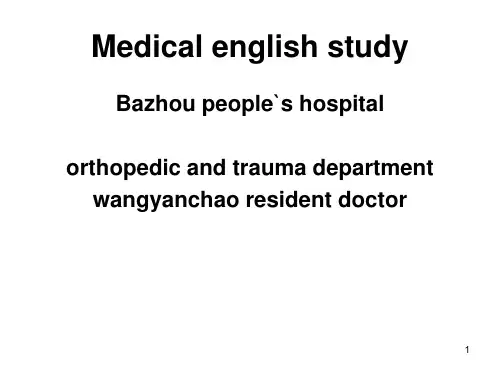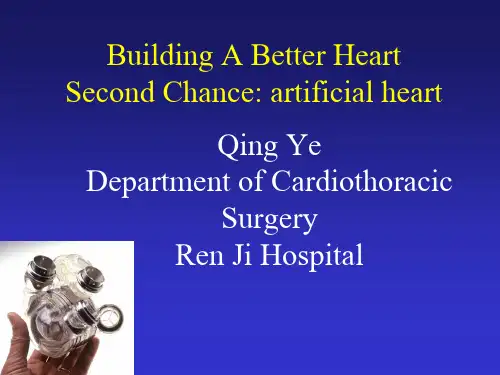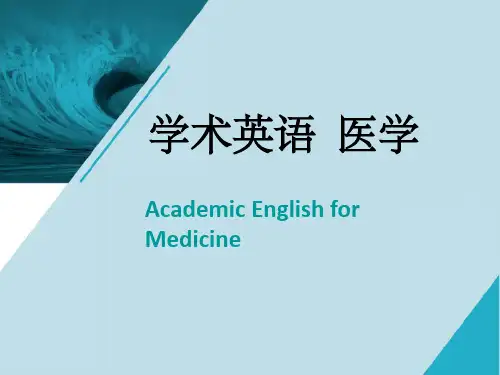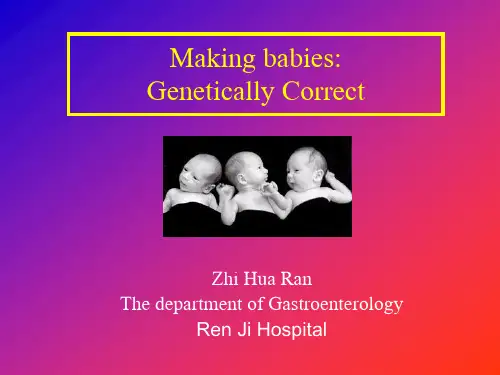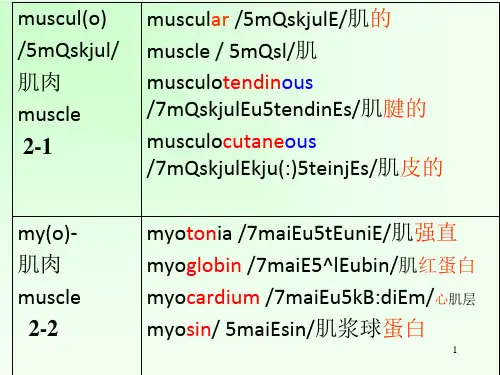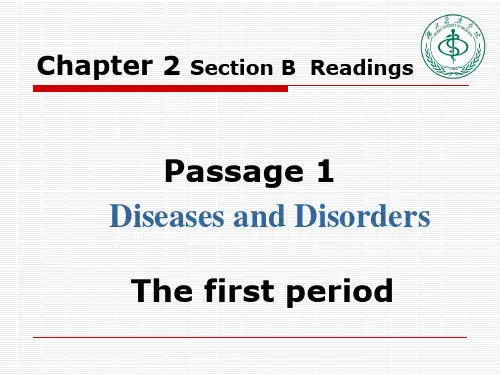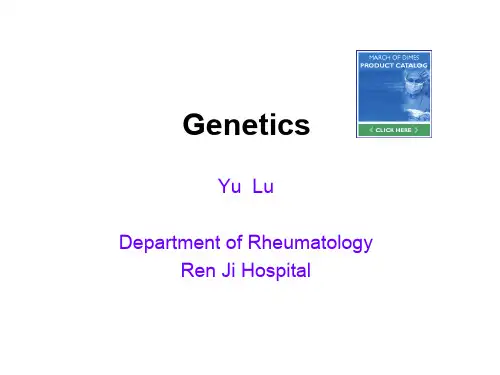医学专业英语Chapter.ppt
- 格式:ppt
- 大小:280.50 KB
- 文档页数:47

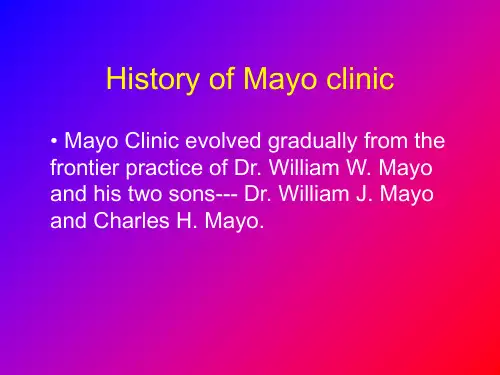
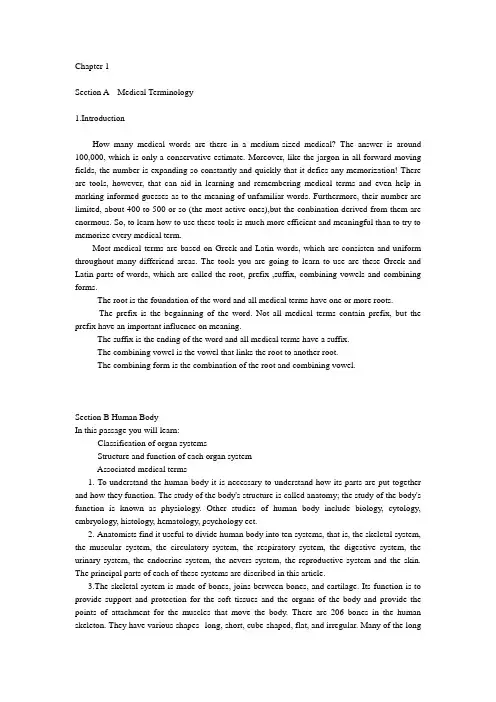
Chapter 1Section A Medical Terminology1.IntroductionHow many medical words are there in a medium-sized medical? The answer is around 100,000, which is only a conservative estimate. Moreover, like the jargon in all forward-moving fields, the number is expanding so constantly and quickly that it defies any memorization! There are tools, however, that can aid in learning and remembering medical terms and even help in marking informed guesses as to the meaning of unfamiliar words. Furthermore, their number are limited, about 400 to 500 or so (the most active ones),but the conbination derived from them are enormous. So, to learn how to use these tools is much more efficient and meaningful than to try to memorize every medical term.Most medical terms are based on Greek and Latin words, which are consisten and uniform throughout many differiend areas. The tools you are going to learn to use are these Greek and Latin parts of words, which are called the root, prefix ,suffix, combining vowels and combining forms.- The root is the foundation of the word and all medical terms have one or more roots.- The prefix is the begainning of the word. Not all medical terms contain prefix, but the prefix have an important influence on meaning.- The suffix is the ending of the word and all medical terms have a suffix.- The combining vowel is the vowel that links the root to another root.- The combining form is the combination of the root and combining vowel.Section B Human BodyIn this passage you will learn:- Classification of organ systems- Structure and function of each organ system- Associated medical terms1. To understand the human body it is necessary to understand how its parts are put together and how they function. The study of the body's structure is called anatomy; the study of the body's function is known as physiology. Other studies of human body include biology, cytology, embryology, histology, hematology, psychology ect.2. Anatomists find it useful to divide human body into ten systems, that is, the skeletal system, the muscular system, the circulatory system, the respiratory system, the digestive system, the urinary system, the endocrine system, the nevers system, the reproductive system and the skin. The principal parts of each of these systems are discribed in this article.3.The skeletal system is made of bones, joins berween bones, and cartilage. Its function is to provide support and protection for the soft tissues and the organs of the body and provide the points of attachment for the muscles that move the body. There are 206 bones in the human skeleton. They have various shapes--long, short, cube-shaped, flat, and irregular. Many of the longbones have an interior space that is filled with bone marrow,where blood cells are made.4. A joint is where bones are joined together. The connection can be so close that no movement is possible, as is the case in the skull.Other kinds of joints permit movement: either back and forth in one plane--as with the hinge joint of the elbow--or movement around a single axis--as with the pivot joint that permits the head to rotate. A wide range of movement is possible when the ballshaped end of one bone fits into a socker at the end of one bone fits into a socket at the end of another bone, as they do in the shoulder and hip joints.5. Cartilage is a more flexible material than bone. It serves as a protective, cushioning layer where bones come together.It also connects the ribs to the breastbone and provides a structural base for the nose and the external ear. An infant's skeleton is made of cartilage that is gradually replaced by bone as the infant grows into an adult.6.The muscular system allows the body to move, and its contractions produce heat, which helps maintain a constant body tempreture. Striated muscles can be constiously controlled.The ends of these muscles are attached to different bones by connective tissue bands so that when the muscle contracts, one bone moves in relation to the other. This makes it possible to move the whole body,as when walking, or to move just one part of the body, as when bending a finger.7.Contractions of the heart and smooth muscles are not under conscious control. Smooth muscles are found in the walls of the organs such as the stomach and the intestines and serve to move the contents of these organs through the body.8.The circulatory system. All parts of the body must have nourishment and oxygen in order to function and grow, and their waste products must be removed before they accumulate and poison the body. The circulatary system distributes needed materials and removes unneeded ones. It is made up of the heart, blood vessels,and blood,which together make up the cardiovascular system.The blood is also part of the body's defense system.It has antibodies and white blood cells that protect the body against foreign invaders.9.The heart is a muscle that is divited into two nearly identical halves: one half receives boold from the lungs and sends it to the rest of the body, the other half sends blood that has traveled through the body back to the lungs.When the heart muscles contracts,the blood is forced out into arteries and enters small capillaries. Blood returns to the heart through veins.10.Also functioning in circulation is the lymphtic system.Some of the fluid that surrounds cells does not reenter the blood vessels directly.This fluid, called lymph, returns to the heart by way of another system of channels--the lymph vessels.Lymph nodes along these vessels filter the fluid before it reenters the blood.The spleen is a large lymphatic organ that filters the blood.11.The respiratory system takes in oxygen from the air and expels carbon dioxide and water vapor.Air enters the nose and mouth and travels through the larynx,and trachea.The trachea divedes to enter each of the teo lungs and then divides more than 20 times to form a very large number of small air spaces. Oxygen from the air enter the blood through capillaries in the walls of these air spaces,and the blood releases carbon dioxide into the air spaces to be exheled.12.The digestive system consists of a tube extending from the mouth to the anus.In it, food and fluids are taking in,moved through the body,and broken down into small molecules that are obsorbed into the circulatory system.This breakdown, known as digestion,is both a mechanical and a chemical process.13.Food enters through the mouth, where chewing and saliva start to break it up and make it easier to swallow.Next the food travels down through the esophagus to the stomach.Contraction ofthe stomach's muscular wall continue to break down the food mechanically,and chemical digestion continues when acid and enzymes are secreted into the stomach cavity.14.The liquified food gradually passed into the small intestine.In the first part of the small intestine,called the duodenum,enzymes from the pancreas are added. These enzymes complete the chemical breakdown of the food.The digestion of fat is added by bile,which is made in the liver and stored in the gall bladder.The small intestine of an adult is about 21 feet(6.4 meters) long.Most of its length is devoted to avsorbing the nutrients released during these digestive activities.15.The liquid remainder of the food enters the large intestine,or colon,which is about 12 feet(3.7 meter) long.It is more than twice as wide as the small intestine.In the large intestine most of the fluid is absorbed, and the relatively dry residues are expelled.16.The urinary system maintains normal levels of water and of certain small molecules such as sodium and potassium in the body. It does this by passing blood through the kidneys, two efficient filtering organs that get rid of any excess of various molecules and conserve those molecules that are in short supply.17.The fluid that leaves the kidneys,known as urine,travles through a tube called the ureter to the bladder.The bladder holds the urine until it is voided from the body through another tube, the urethra.18.The endocrine system. The two system that control body activities are the endocrine system and the nervous system.The former exerts its control by means of chemical messengers called hormones. Hormones are produced by a variety of endocrine glands, which release the hormones directly into the blood stream.19.A major gland is the pituitary, which is located under the brain in the moddle of the head.It produces at least eight hormones, which affect growth, kidney function, and development of the sex organs.Because some of the pituitary's hormones stimulate other glands to produce their own hormones,the pituitary is called the master gland.20.Another gland, the thyroid is located between the collar bones.Its hormone controls the rate of the body's metabolism.The sex organs(ovaries and tests)make the sex cells and also make hormones that control certain characteristics of the males and females. Located on the top of each kidney is the adrenal gland,which produces cortisone and adrenaline.The pancreas produce not only digestive enzymes but also insulin and glucagon, which control the body's use of the sugar and starches.21.The nervous system--the brain, the spinal cord, and the nerves--also controls body activities.The lower parts of the brain control basic functions such as breathing and heart rate as well as body temperature ,hunger,and thirst.Above these regions are the centers for sight, sound, touch, smell, and taste, and the regoins that direct voluntory muscular activities of the arms and legs.Performed here are the higher functions of integrating and processing information.22.The brain receives and sends information by means of nerves, many of which lie partly in the spinal cord.The spinal cord is protected by the spinal column.Nerves enter aand leave the spinal cord at each level of the body,traveling to and from the arms, legs, and trunk.These nerves bring information from the various sence organs.The information is processed by the brain, and the messages are carried back to muscles and glands throughout the body.23.The reproductive system is constructed differently for males and females. The male reproductive system is responsible for producing , transporting and maintaining viable sperm(the male sex cell).It also produces the male sex hormone, testosterone, which regulates thedevelopment of a bread, pubic hair, a deep voice and other bodily characteristics of the adult male.24.The female productive system is responsible for producing and transporting ova(the female sex cells) eliminating ova from the body when they are not fertilized by sperm, and nourishing a newborn child.The female reproductive system also produces the female sex hormones, estrogen and progesterone, which regulate the development of breasts and other bodily characteristics of the mature female.25.The skin is complete layer that protects the inner structures of the body, and it is the largest of the body's organs.It keeps out finger substances and provents excessive water evaporation.The nerves in the skin provide tactile information.The skon also helps keep the body's temperature close to 98.6℉(about 37℃): heat is conserved by reducing blood flow through the skin or is expended by increasing blood flow and by evaporation of sweat from the skin.Hair and nails are accessory structures of the skin.第一章医学术语A部分1.Introduction有多少医学词是在一个中等大小的体检吗?答案是大约10万,这只是保守的估计。
